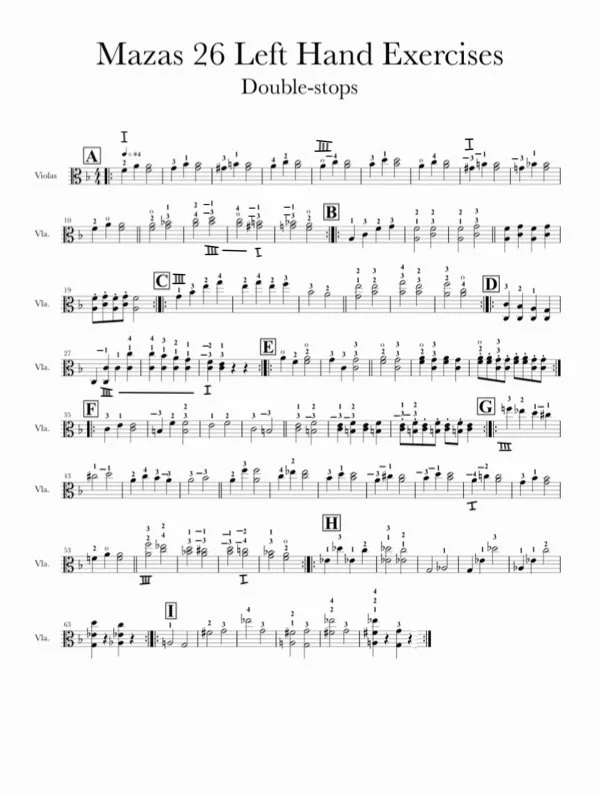IN THIS LESSON
DOUBLE-STOPS ARE A MAJOR FEATURE OF MAZAS #26: BE READY TO SHOW OFF YOUR THIRDS, FOURTHS, AND SIXTHS.
These exercises are designed to help you hear each note individually before combining them into double stops. Listen for any clashing or pulsing sounds, which indicate that the intonation needs adjusting. If you hear this, go back to playing the individual notes again. The second half of each exercise focuses on transitioning between double stops. If a double stop is out of tune, go back one note and practice moving to the double stop in tune. Repeat this process back-and-forth a few times for better accuracy.
Bow Use in Double Stops
Double stops require a faster bow to make both strings sing, not a heavier bow! Ensure your bow moves openly and freely.
Left Hand in Double Stops
Make sure your left hand, wrist, and thumb are all relaxed
Open from the base knuckle to reach for notes
Exercise A
Objective: Play thirds in tune up and down D + A string
Measure 1: Build thirds in first position.
Thirds rise chromatically in measures 2-4.
In measure 5, shift to 3rd position. Play A&C using open A and 4th finger C on the D string.
Measure 6 stays in 3rd position. Place 3 on D string and 1 on A string.
Measure 7 returns to A and C, again open A and 4th finger C.
In measure 8, return to the first position and chromatically descend in measure 9.
Measures 11-14 practice moving through the sequence as double stops.
Exercise B
Objective: Hear and move between the notes for this double stop set.
Begin by playing and hearing the four notes individually, then build into double stops.
Practice moving between double stop sets, first slowly and sustained, then faster with a quick release stroke.
In measure 19, the bow should stay open and close to the string in a scoopy off-stroke.
Exercise C
Objective: Feel the notes and hand frame for double stops in third position on the D and A strings.
In measure 23, ensure correct finger placement: the 2nd finger stays down on the A string while the D string moves from 1 to 3.
In measure 24, ensure 3rd finger stays down on the D string while the A string moves from 2 to 4.
Exercise D
Objective: Double Stops against the note C.
First drone is open C, moving in measure 27 to 1st finger C in third position on the G string.
Ensure all C’s played throughout the exercise match.
Exercise E
Objective: Hear and move between the notes for this double stop set.
Build the two sets of double stops.
Practice moving between double stop sets, first slowly and sustained, then faster with a quick release stroke.
When playing a fifth and covering two strings with one finger, aim to place your finger precisely between the two strings, using the meaty part of your finger pad.
Experiment with balancing the pressure more toward the low or high string to find what feels comfortable and sounds in tune.
Exercise F
Objective: Hear and move between the notes for this double stop set.
Build the two sets of double stops.
Practice moving between double stop sets, first slowly and sustained, then faster with a quick release stroke.
In measure 36, the third finger shifts from its normal location to the “high 2” location in this chromatic hand frame
Exercise G
Objective: Hear each voice then combine, in this chromatic double stop sequence.
Measures 42-43 isolate the A string voice - spend time memorizing how this line sounds
Measures 44-45 isolate the D string voice - spend time memorizing how this line sounds
Measures 46-53 build the voices together as double stops
Measures 54-57 practice moving from one double stop to the next.
Exercise H
Objective: This exercise focuses on building three-note chords, allowing time to hear how each voice moves from note to note.
Exercise I
Objective: This exercise builds up a tense-sounding three-note chord that resolves to a set of octave G’s.
-
Sevcik books are a staple of string technique building - his Opus 9 book on Doublestops is an amazing tool for continued work on this skill.
